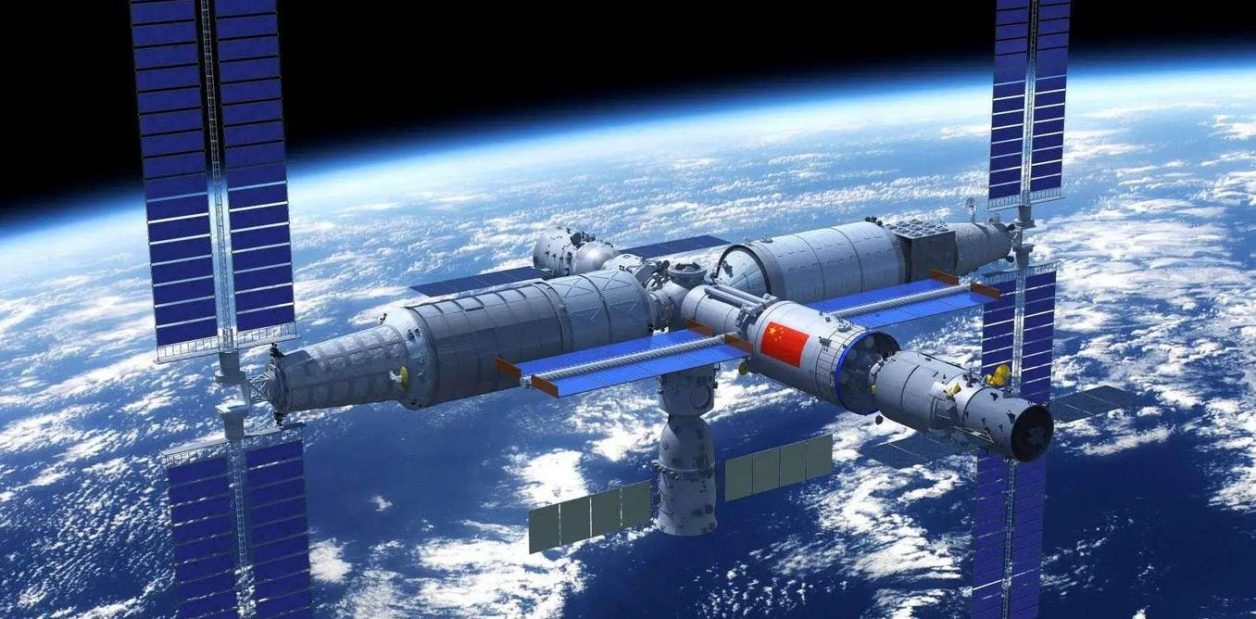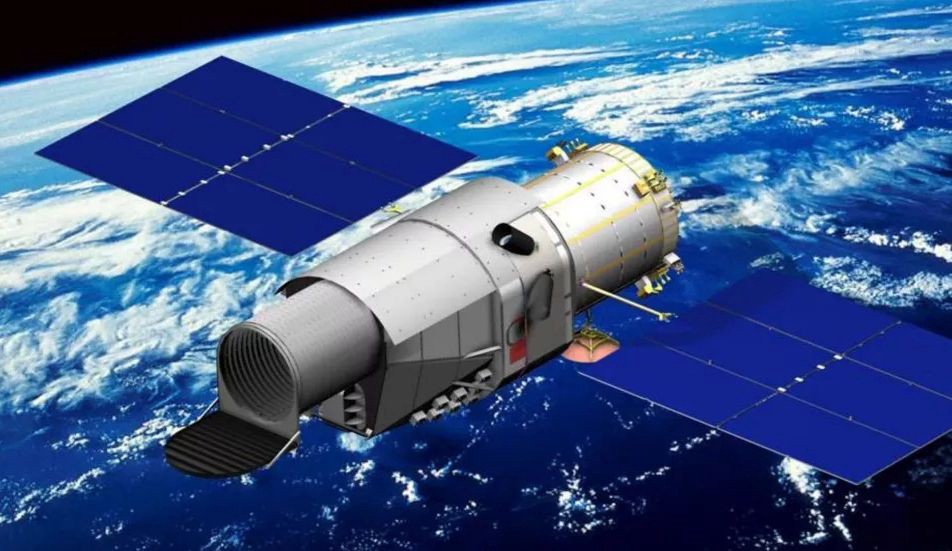With China’s Tiangong Space Station set to become operational this year, Beijing is poised to advance its burgeoning space program. This development comes at a time when the International Space Station (ISS) is struggling with an internal conflict and could retire by 2030.
“On The Prowl” — Chinese Y-8 Anti-Sub Aircraft Joins J-20 Fighters, Aircraft Carrier Battle Group For Combat Ops
Tiangong space station, whose first module was launched last year, is 340 miles above the Earth’s surface, approximately 100 miles higher than the International Space Station, and has a mass of about a fifth of the ISS.
China has some ambitious plans for the Tiangong, including inviting international and commercial partners to participate and visit the facility. It is also reportedly working to welcome international astronauts to its Space Station, which was revealed at a press conference held last month.
The Chinese Space Agency (CNSA) plans to launch six major missions before the end of the year to complete the space station, which will soon be connected to a powerful telescope and host commercial operations and foreign astronauts, informed the officials at the press conference.
“Averting A $3.2 Trillion Loss” — China Holds Emergency Meeting To Protect The Country From Russia-Like Sanctions
Two more modules, i.e., the area in the space station where the astronauts live and work, will be added to the existing habitation unit. Currently, the Tiangong Space Station has just one core module, called Tianhe, which was launched in 2021.

The ambitious announcements about the future of China’s own space station come at a time when the only space station in the world, the ISS, is in the midst of an intense political battle due to the Russia-Ukraine War.
As a consortium of space agencies, including Russia, the ISS grapples with stark divisions as Moscow refuses to end its ‘special military operations’ in Ukraine.
Many space collaborations with Moscow have either been halted or, hang in the balance as the war rages on in Eastern Europe. Russia also announced that it has decided to quit the ISS, a news that was debunked by NASA Chief. However, Moscow’s exact intentions remain unknown.

The uncertainty gripping the ISS due to the Ukraine war, escalating tensions among its members, and its retirement inching closer could collectively become a perfect setting for China’s resurgence through a successful space station.
A race for space dominance continues between China and the US (with NASA being an influential member of the ISS), with the US trying to preserve the status quo and China trying to dismantle it.
China’s Grand Plans For Tiangong
According to the head of the China Manned Space Engineering Office (CMSEO), Hao Chun, the six planned critical missions would begin in May with a resupply trip, followed by the six-month-long Shenzhou 14 crewed voyage in June.
Russia’s “Invisible Missiles” – Meet Putin’s Five ‘Super-Weapons’ Than Even US President Called Impossible To Intercept
The Tianhe core module will be joined in orbit by a second module, Wentian (“Asking the Heavens”), in July, and a third and final module, Mengtian (“Dreaming of the Heavens”), in October. The completion of the Tiangong Space Station would mean three modules or living units for Chinese astronauts in space.
Wentian(问天/HeavenlyQuestion) and Mengtian(梦天/HeavenlyDream) experiment modules. Both will be launched this year and dock with Tiangong Space Station (CSS). Source: https://t.co/rNwJvAQQQO pic.twitter.com/pY7F7Q3IIh
— CNSA Watcher (@CNSAWatcher) January 25, 2022
The Tianzhou 5 cargo and Shenzhou 15 crewed missions will be launched later this year, when the Tiangong station will host its first crew rotation, with the Shenzhou 14 astronauts welcoming the newcomers aboard, thanks to extra living quarters of the Wentian module.
The last crewed mission involving three astronauts returned to earth last month after spending 183 days in microgravity.
Further, China’s announcement to invite space tourists and astronauts from other space agencies is significant as it comes in the backdrop of the first-ever private mission to ISS aboard a SpaceX spacecraft.
The mission was given the name Ax-1 after Axiom Space, which acted as a form of space travel agency, paying SpaceX for two-way transportation and NASA for the use of the orbiting facilities.

China also plans to connect the station to a powerful space telescope’s control center. According to its space agency, the Xuntian space telescope is identical to NASA’s Hubble but has a 300-fold larger field of view.
It will be in a shared orbit with Tiangong, allowing it to dock for repairs, upgrades, and refueling as and when needed.
‘Flying Kremlin’: Russia’s Powerful Aircraft Designed For A Potential ‘Nuclear War’ Spotted Over Moscow
Tiangong will host six-month crewed flights after it is fully assembled, during which astronauts will conduct a variety of experiments and outreach activities.
The Chinese Space Agency (CNSA) is also considering expanding the space station’s capabilities and the scope of its activities and developing new ways to approach Tiangong.
“We’re developing the extending modules and cabins of the spacecraft to conduct more experiments and provide better living conditions for the astronauts,” Hao said.
According to previously stated expansion plans, Tiangong could eventually be expanded to six modules.
The overall construction of Tiangong Space Station (CSS) will be finished with two experiment modules launching this year. 6 astronauts (Shenzhou 14 & 15 crews) will work at the same time in the station for a certain time period by the end of this year. https://t.co/Paqcg98Z56 pic.twitter.com/sXOnpfuxTn
— CNSA Watcher (@CNSAWatcher) February 10, 2022
“We’ll also actively explore new models of commercial human spaceflight and introduce commercial cargo,” Hao said. Earlier, EurAsian Times had reported how China was gearing to open the space station to commercial activities for ‘competitive, innovative players.’
The lead designer of China’s manned space program, Zhou Jianping, had earlier stated that international astronauts would be welcomed onboard Tiangong in the future.
“We would actively promote foreign astronauts’ participation in the work in China’s space station, which is an important part of international cooperation. You look forward to it, I look forward to it too,” Zhou had told CGTN.
With the International Space Station retiring sometime in 2030, China’s Tiangong will be the lone space station in the world. While the ISS is a consortium, China will be the only country to operate its own space station once Tiangong becomes operational.
Even though Russia is a vital part of the ISS, it is pertinent to mention that China is not a part of the international consortium. Since the collapse of the Soviet Union (USSR), the US has somewhat enjoyed complete space dominance with NASA’s astonishing budget.
However, it appears that China is now aggressively replacing the former USSR and is actively challenging the might of the American space program.
- Contact the author at sakshi.tiwari9555@gmail.com
- Follow EurAsian Times on Google News




